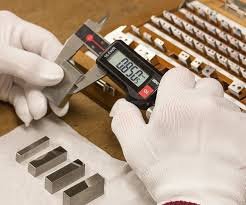Calibration of Vernier Caliper

Calibration of Vernier Caliper
1. Introduction
A Vernier Caliper is a precision measuring instrument used to measure internal dimensions, external dimensions, and depths. Calibration ensures measurement accuracy within specified tolerances, critical in quality control and manufacturing.
2. Objective
-
To verify that the Vernier caliper provides measurements within the acceptable tolerance range.
-
To comply with GMP, ISO 17025, and quality system requirements.
3. Principle
Calibration is performed by comparing the Vernier caliper’s reading against a certified standard (e.g., gauge blocks) whose dimensions are traceable to national or international standards.
The difference between the measured value and the standard value is the calibration error.
4. Equipment Required
-
Vernier caliper to be calibrated
-
Certified gauge blocks (calibration certificate traceable to NIST or equivalent)
-
Clean lint-free cloth
-
Calibration record sheet
5. Procedure
-
Clean the Caliper – Remove any dust, oil, or debris.
-
Zero Error Check – Close the jaws and check if the reading is 0.
-
If there’s a positive or negative zero error, note it.
-
-
External Measurement Calibration – Measure gauge blocks of known length (e.g., 10 mm, 50 mm, 100 mm).
-
Record caliper reading and calculate error:
Error=Measured Value−Standard Value\text{Error} = \text{Measured Value} – \text{Standard Value}
-
-
Internal Measurement Calibration – Use standard ring gauges or calibrated internal measurement tools.
-
Depth Measurement Calibration – Use depth setting blocks or standard depth gauges.
-
Repeatability Check – Take multiple readings for the same standard to verify consistency.
-
Acceptance Criteria – Typically ±0.02 mm for a 0.02 mm resolution caliper (per manufacturer’s specification or ISO guidelines).
-
Documentation – Record results, calibration date, due date, instrument ID, and sign-off.
6. Frequency
-
Before first use
-
At least annually
-
After repair or suspected damage
7. References
-
ISO 13385-1: Vernier, dial, and digital calipers – Design and metrological characteristics
-
NABL / ISO 17025 calibration requirements

